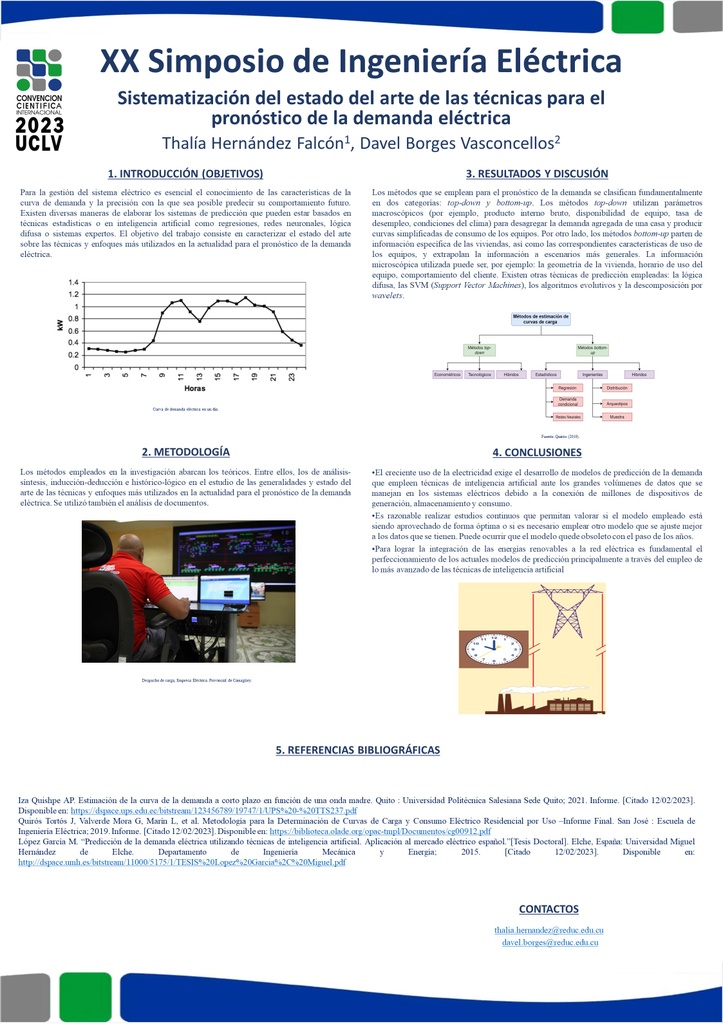Executive Secretary

XX International Symposium of Electrical Engineering
SIE 2023

Abstract
Problem: Currently, at a global level, the forecast of electricity demand is essential due to the integration of smart grid systems into current energy systems and the penetration of renewable energy sources, which makes this process more complex and Demand newer techniques.
Objective: Characterize the state of the art on the techniques and approaches most used today for electricity demand forecasts.
Methodology: Document analysis, analysis-synthesis, induction-deduction and historical-logical.
Results and discussion: It is specified that it is important for each country to carry out the pertinent studies to carry out the adjustments of load curves that correspond to each region, taking into account culture, climate and customs. Having adequate curves that reflect the behavior of a system prevents overloads in the feeders, transformers and oversizing of these, which guarantees the stability, availability and efficiency of the electrical system.
Conclusions: The growing use of electricity requires the development of demand prediction models that use artificial intelligence techniques in the face of the large volumes of data handled in electrical systems. It is reasonable to carry out continuous studies that allow us to assess whether the model used is being used optimally or if it is necessary to use another model that better fits the data available. To achieve the integration of renewable energies into the electrical grid, the improvement of current prediction models is essential.
Resumen
Problemática: Actualmente a nivel mundial el pronóstico de la demanda eléctrica se hace indispensable por la integración de los sistemas de redes inteligentes a los sistemas de energía actuales y la penetración de las fuentes de energía renovable, lo cual provoca que este proceso sea más complejo y exija técnicas más novedosas.
Objetivo: Caracterizar el estado del arte sobre las técnicas y enfoques más utilizados en la actualidad para el pronóstico de la demanda eléctrica.
Metodología: Análisis de documentos, análisis-síntesis, inducción-deducción e histórico-lógico.
Resultados y discusión: Se precisa que es importante que cada país realice los estudios pertinentes para ejecutar los ajustes de curvas de carga que correspondan a cada región atendiendo a la cultura, el clima y las costumbres. Contar con curvas adecuadas que reflejen el comportamiento de un sistema evita sobrecargas en los alimentadores, en los transformadores y sobredimensionamiento de estos, lo cual permite garantizar la estabilidad, disponibilidad y eficiencia del sistema eléctrico.
Conclusiones: El creciente uso de la electricidad exige el desarrollo de modelos de predicción de la demanda que empleen técnicas de inteligencia artificial ante los grandes volúmenes de datos que se manejan en los sistemas eléctricos. Es razonable realizar estudios continuos que permitan valorar si el modelo empleado está siendo aprovechado de forma óptima o si es necesario emplear otro modelo que se ajuste mejor a los datos que se tienen. Para lograr la integración de las energías renovables a la red eléctrica es fundamental el perfeccionamiento de los actuales modelos de predicción.
About The Speaker

Thalía Hernández Falcón

Discussion

